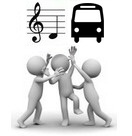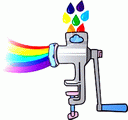 |
|
||||||||||||
|
The word "rebus" comes from the Latin res (thing) and denotes representation of names, words and phrases by a images, figures, composition of letters, etc. This word came from the Latin phrase "Non verbis sed rebus", which means "Without words, but with the help of things". Each of us certainly met with rebuses in everyday life. Undoubtedly , the most famous and popular puzzle looks like this : i ♥ u ( pronounced "I Love You" ) . Thus, in the modern sense , is a rebus puzzle , consisting of images of objects ( drawings in combination with other compositions and alphabetic characters ) , congruent with the words or parts of words . Several puzzles can be combined into a single picture or in a sequence of patterns in order to create a phrase or sentence. In the literature for the preparation of proposals Rebus used letters, numbers , musical notes , or specially arranged words. Puzzles can transmit direct meaning of the words , mainly to inform or instruct the illiterate people , either intentionally obscure their meaning to inform only the initiated. However, most often used as a rebus puzzles and entertainment. Using primitive images to convey information formed the basis of the earliest writing systems ancient Egyptian culture ( line 4th and 3rd millennia BC ) . The earliest form of rebus occurs in picturesque letter in which abstract words that are difficult to image, subjects were presented with images whose names were pronounced the same way. Later picture puzzles used to transmit the names of cities in the Greek and Roman coins . Puzzles remained popular in the Middle Ages - they appear on buildings or objects of ownership , to refer to generic names. Practice to use as puzzles or riddles jokes originated in XV century France . Originally called rebus special kind of farce performances containing libels that clowns in Picardy amused people annually during the carnival . In allegorical form comedians ridiculed the vices and weaknesses of the mighty. Their performances authors gave the Latin name "De rebus quae geruntur", ie " One Day " (literally " on the cases which are being done " ) . In the sixteenth century. , Fun when these were banned by the authorities , the nature of the rebus changed. Rebus were called pun pun . Often it was a puzzle , consisting of images of different objects (often interspersed with letters, numbers and music notes ) , whose names do not represent concepts expressed subject clue words, but resemble them in pronunciation or consonance ( without relation to spelling ) . For example, depicted in Rebus horse , tea , ribbons , roses read : ending frost ; forehead, zeros - burst , etc. The first known manuscript collections puzzles are top end XV XVI century. In 1582 ( ? 1562 ) came the first printed collection called "Les Bigarurres du Seigneur des Accords", which had a great success and went through several editions . Its author was Taboureau Etienne (Etienne Tabourot, 1548-90) - French poet , known as the seigneur des Accords, excellent " rhymer " more distinguished poetic foci ( acrostics , anagrams , etc. ) than really poetic works . Les Bigarurres du Seigneur des Accords ( 1582 ) His book is a treatise on the puzzles. However, figures it all a dozen . Most puzzles Taboureau transfers in the form of humorous stories. For example, an abbot on an order to leave the Abbey replied: " I used 30 years studying the first two letters of the alphabet ( AV ) and wish to have as much time to read the following two letters" ( S.D. ) . Under AV he meant Abbey (abbaye), a by S.D. - Verb "c e der" ( give a way ) . From the literary sphere puzzle spread in France on noble emblems , signs commercial establishments and even appeared on the gravestones and prayer books . From France fashion puzzles moved to Italy, England and Germany. Several hundred puzzles masters XVII - XIX centuries are kept in the Museum of London . For example, dates back to the year 1639 the work of the Florentine engraver and artist Stefano della Bella (Stefano della Bella), made in the form of an oval cartouche titled " Rebus luck ." Children's Bible Isaiah Thomas ( 1788 ) In 1783, the English painter and engraver Thomas Bewick (Thomas Bewick) in London Publishing T.Hodzhsona (T.Hodgson) prints unusual Bible for children, in which event the Holy Scriptures retold in the form of riddles . Made so the Bible was called " hieroglyphics " . In it are some words from the text replaced pictures with the aim to retell the story in a direct, easy and fun way . A few years later , in 1788 , the American publisher of Isiah Thomas (Isaiah Thomas) publishes hieroglyphic Bible overseas. In the preface to his edition of Thomas is the first American hieroglyphic Bible as illustrated more than his English prototype. Such unusual hieroglyphic Bible have become very popular in the late XVIII century , it facilitates the teaching of Holy Scripture children. Fragment of letter rebus Lewis Carroll (XIX century), English writer and mathematician Charles Lutwidge Dodgson , better known under the pseudonym Lewis Carroll , one of the most popular children's writers of the XIX century, the author of fairy tales " Alice in Wonderland " and " Alice in Wonderland " is often puzzles used in a large correspondence with young admirers of his work. In their letters , and they are not nearly as many as 100,000 ! , He often replaced the picture of the words or characters depicted in mirror image . To read these mysterious letters needed savvy, that none might not like children. French earthenware plate XIX century rebus In the second half of the XIX century puzzles have been widely used in everyday life. They appear on the pages of newspapers and magazines , postcards , table accessories . In trendsetter - France, released a series of porcelain plates on the front of which was depicted rebus , and on the back - the solution . TV show "The Rebus Game" ( 1965 ) Since the beginning of the television era in the West, puzzles to get blue screens . March 29, 1965 American television channel "ABC" starts 30- minute television show "The Rebus Game" with Jack Linkletter (Jack Linkletter). Participants are encouraged to solve puzzles encrypted with words. For each guessed rebus provided monetary compensation. The main prize for the winner of the TV show was a car worth 5,000 U.S. dollars. Smiley rapid development of computer technology, information technology and telecommunications also been affected puzzles. At the turn of the century , with the growing popularity of mobile communication formed a special SMS- Slang, which was the main characteristic brevity. Literally it meant , the smaller the number of letters or characters - the better. That's why " language SMS" got all sorts of acronyms and abbreviations. With the growing popularity of the Internet and social networking is the direction in every way and transformed acquires new words. Here are just a few examples of modern computer slang : "cul8r" (see you later), "b4" (before), "gr8" (great). Like Rebus individual letters and numbers replace similar-sounding words and phrases . We should also mention the " emoticons " as a simple and effective means of expressing emotions , without which communication network is simply impossible to imagine ;)
|
||||||||||||
| Rebus Number One, 2014 - | rebus1.com © All rights reserved SirotaSOFT |
 The History of Rebus
The History of Rebus



